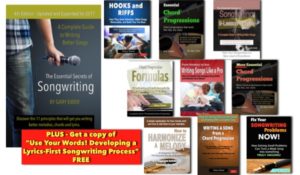When we talk about the form of a song, we’re usually talking about the arrangement of its basic elements such as verse, chorus and bridge. That word form, though, can refer to other things: aspects of the lyric, the design of a melody, or how keys are established and changed as a song progresses.
Listeners to your songs are only vaguely aware of the formal design of your song, but that’s mostly due to the fact that they don’t usually have the vocabulary to describe what they’re hearing. So aspects of the formal design of your song are actually quite noticeable to your audience, but mostly on a subconscious level.
 Thousands of songwriters are using The Essential Secrets of Songwriting eBooks to straighten out their songwriting problems. Have you been spending years just reinforcing errors? Sort out your technique! Get today’s free deal!: a copy of “Use Your Words!”
Thousands of songwriters are using The Essential Secrets of Songwriting eBooks to straighten out their songwriting problems. Have you been spending years just reinforcing errors? Sort out your technique! Get today’s free deal!: a copy of “Use Your Words!”
That means that when you change things relating to the design of your song, you can make a strong impact on your audience, even though they may not be consciously aware of what’s causing that impact.
Generally, any time you change what audiences are expecting, you grab their attention. You hope, of course, that they have a positive reaction to those changes. Playing around with the formal elements that make up the design of your song can be a good way to make it a little less predictable, and possibly more exciting.
Here’s a quick, short list of things you might consider that pertain to the design of your music. It’s time to experiment:
- Start with the chorus. Starting a song with the verse makes sense because a verse is where we describe people or situations, and choruses are where we express emotions about those situations. So starting with the chorus can be exciting and unexpected. It won’t necessarily work for every song, but if your song needs a shot of excitement out of the gate, a chorus-first design is a great option. Example: “Rehab” (Amy Winehouse).
- Jump to the bridge after a verse instead of after a chorus. It’s typical to place the bridge after the second chorus. So typical that it’s hard to find a song that uses a bridge where that doesn’t happen. But Genesis’ 1982 hit “Paperlate” is a good example. The bridge happens after Verse 2 (2’08”), just as you’re expecting the chorus. (It’s also an example of a song starting with a chorus.)
- Start a song with an instrumental (or an instrumental solo). An instrumental at the start of your song can be an interesting way to keep your audience guessing. A great classic rock example is Supertramp’s “Bloody Well Right” from their “Crime of the Century” album (1974). If you’re starting with an instrumental, it’s got to be good enough, and played well enough, that your audience isn’t simply waiting in frustration for the song to start.
- Start a song with spoken word. Weezer’s 1994 song “Undone – The Sweater Song” (Rivers Cuomo) starts with a background conversation during the intro. A great way to have your song stand out from most songs out there.
- Abandon the main idea of your song, and then return to it. Eric Carmen did this when he wrote “All By Myself“, and, after the second chorus, created a lovely piano/orchestra bridge that bears little resemblance to the main portion of the song. In fact, Carmen wrote this interlude first, and then composed the rest of the song (the verse melody of which is a lift from Sergei Rachmaninoff’s Piano Concerto No. 2 in C minor, Opus 18). You don’t need to hire an orchestra to do this kind of musical diversion. It can be anything that serves as a pleasant deviation from whatever the song has presented. You need to be careful, though, and make sure that your radically different section isn’t so odd that it detracts from the rest of the song.
Written by Gary Ewer. Follow Gary on Twitter.

 “Hooks and Riffs: How They Grab Attention, Make Songs Memorable, and Build Your Fan Base” shows you how a good hook can make the difference between songwriting success and failure. With great examples from pop music history.
“Hooks and Riffs: How They Grab Attention, Make Songs Memorable, and Build Your Fan Base” shows you how a good hook can make the difference between songwriting success and failure. With great examples from pop music history.











Pingback: Changing Up the Form of Your Song | The Essential Secrets of Songwriting – All About Songwriting News